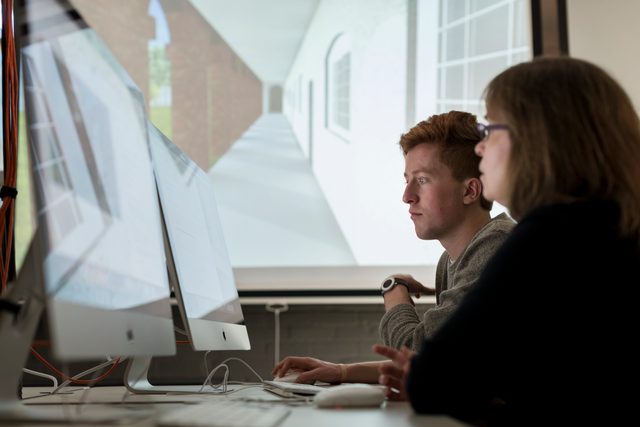 Even in advance of the new science facility, Carleton faculty members have been forging innovative partnerships between STEM and other disciplines.
Even in advance of the new science facility, Carleton faculty members have been forging innovative partnerships between STEM and other disciplines.
History professor Susannah Ottaway’s 3D computer modeling of 18th century English workhouses is a prime example. To give her students a deeper perspective on how these spaces were established, Ottaway approached two digital humanities associates—student employees dedicated to helping humanities professors like Ottaway with technological projects—about constructing a three-dimensional model of a workhouse.
“Building the workhouse in model form gave us a whole new set of questions as to how it functioned and why it was constructed in a specific way. It’s been transformative to the kind of research questions we need to be asking,” Ottaway says. “But even more important than that, it has helped students recreate the lives of the people in that time, and in the process, generate greater empathy. They’ve been able to think more about how the poor were put to work—for instance, how much it hurt to hold a laundry bag with splinters over the course of a 10-hour workday.”
Meanwhile, Austin Mason, assistant director for digital humanities, is helping to expand Ottaway’s original proposal by introducing gaming elements that make the virtual workhouse more interactive. “The really interesting work with these formats happens when you incorporate insights from the gaming world,” he says. “You can explore a realm where you make choices that can influence how you proceed.”
Ottaway visited England with her two digital humanities associates—Florence Wong ’16 (Hong Kong) and Graham Earley ’17 (Minneapolis)—to scan primary source documents and visit buildings that once served as workhouses. At one of those structures, now the Gressenhall Farm and Workhouse museum, Ottaway met a curator who was more than willing to serve as a partner for archived information and questions related to building dynamics.
Pulling from all corners of campus also kept the collaboration flourishing. Wong, a studio art major, added her own creative flair to the model’s design. Earley, a computer science major, brought his love of software development. And as Ottaway and Mason soon discovered, while their expertise as history professors steered the model toward its academic goal, it often took Earley’s CS-centered brain to question fundamental details such as how a staircase should look or operate in a given space.
Another key contributor was biology major Jeremy Fisher ’16, whose expertise in computer-generated images brought new insights to the project. “His science brain and computer modeling background led to some of the most transformative questions, both for my research and our teaching,” Ottaway says. “His guest lecture on modeling was one of the highlights of our course.”
“We all have our own domain knowledge, and allowing those various skill sets to come together is what let us take things so much further,” Mason says. “We were always thinking about the best way to get something done, and the fact that it’s been so experimental and collaborative has allowed the project to grow organically.”
The “proof of concept” digital model was created for a course Ottaway and Mason cotaught last winter called Bringing the English Past to Virtual Life. The class paired the 3D building with student-researched biographies of English paupers to help tell immersive pathway stories about “people who are not in power—the poor, the criminals, the people who don’t often show up in history books,” says Mason.
That would have been satisfying enough, but the best may be yet to come.
With Earley serving as the bridge between iterations, a computer science comps group is expanding upon the workhouse blueprint. The goal is to create a universal platform where Carleton professors can plug in their own historical elements without writing a single line of code—almost like an “empathy machine” with customizable features. Beyond Carleton, the framework also will be made available as an open source project, allowing anyone to build an interactive experience using the workflow developed by the Carleton team.
“What I’ve learned as a software developer is that you have to think about the framework in a way that anyone can use,” Earley says. “That’s been one of the great benefits of working on this. Not only do I feel like I’ve been taking a history course, but I’ve been exposed to so many unconventional areas where I wouldn’t have thought of applying my CS knowledge.”
Learn more about this innovative project at the History 235 website.
